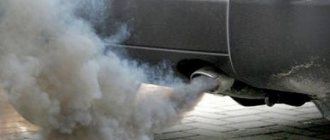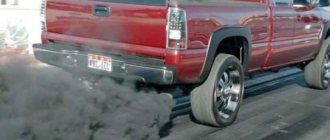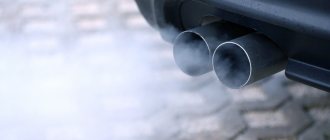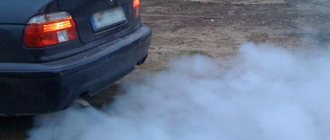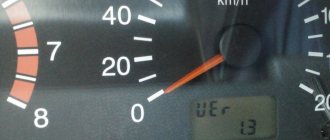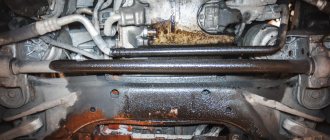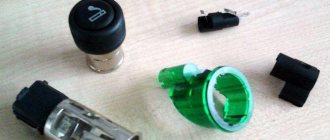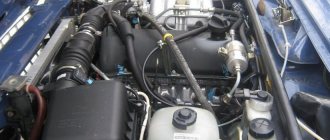Diesels of older generations smoked almost always. At that time, this was not considered a sign of a malfunction, and useless fuel losses due to soot formation could not be considered due to the low cost of fuel. Moreover, no one cared about the environment. Now diesel engines have become as clean as gasoline engines, and the black color of the exhaust is unacceptable even in the most inconvenient modes for fuel equipment developers.
Common causes of smoke
As you know, the fuel-air mixture burns in the engine cylinders. The fuel enters here through the injector nozzles and “meets” the air, which is supplied through the intake manifold. The cylinder pistons create the pressure necessary to mix air with fuel. When the entire system works like a clock, the mixture burns almost completely, and the emission of hydrocarbons into the atmosphere is minimal. The smoke that comes out of the exhaust pipe when the engine starts is the result of incomplete combustion of the fuel mixture for various reasons:
- The injection advance angle is off.
- Uneven fuel spray.
- Insufficient air supply to the cylinder block.
- Fuel is of low quality, with a high concentration of sulfur.
Let us immediately note that it is impossible to find out the exact cause of the breakdown only by the type of exhaust. The color of the smoke will tell you where to look for a problem (cooling system, compressor, etc.), which will save time. But an accurate “diagnosis” will only be made by a complete diagnosis of all systems, which is best not to delay.
Old school
It is worth making a digression and mentioning “old” school engines, whether swirl chamber or direct injection, on which environmental limiters in the form of a particulate filter, catalyst or USR system are not available from the factory or have been cut out/removed by the owners. If gray smoke with a bluish tint in the first minutes after starting the engine in cold weather does not appear in conjunction with poor starting, loss of dynamics, harsh and uneven operation, the owner should not worry.
Slightly decreased compression, deviations in cyclic flow due to wear of injectors, imperfect operation of individual sensors are a natural consequence of long years of operation and high mileage. The owner just needs to make sure that the thermostat, glow plugs, USR and idle speed increase system are in good condition, which are extremely important for quick engine warm-up and smooth operation after a cold start.
Black color of smoke: causes and consequences
The black color of the exhaust is due to its high soot content. Most often, diesel smokes black due to the low cetane number of diesel fuel, or, more simply, due to poor fuel quality. Switching to higher quality diesel fuel will help confirm or refute this guess. If after several starting cycles the smoke color remains the same, then the problem is not in the fuel.
Air filter clogged
The purpose of the filter is to clean the air entering the cylinders from solid particles that can damage the engine. When it becomes clogged, the air supply is reduced, which affects engine power and fuel consumption. If the filter is clogged, fuel burns in vain. If you notice increased fuel consumption along with black smoke, check the filter first. In vehicles equipped with an on-board diagnostic system, the computer will display P0171 or P0172.
The solution to the problem is obvious - the air filter needs to be changed. Car manufacturers advise replacing filter elements every 12 months or every 10-20 thousand km. The “life” of the filter largely depends on the operating conditions of the car. On dusty dirt roads it will clog faster than when driving on smooth, clean asphalt.
The injectors are clogged
If a diesel engine smokes black smoke when cold, does not start on the first try, and stalls when you press the gas pedal, most likely the reason is in the injectors. When using low-quality fuel, tar and sludge accumulate in the spray holes. Cleaning them will help restore the functionality of the injectors. There are two ways to flush injectors:
- Chemical. A special cleaning compound (solvent) is poured into the fuel system and the engine is started several times.
- Physical. The injectors are removed from the engine and placed in a special ultrasonic bath. This method is more effective, although more expensive.
Turbocharger faulty
Black smoke from the exhaust pipe with low engine power and increased oil consumption indicates problems with turbocharging. There may be two reasons:
- air duct blockage;
- Intake/exhaust manifold leaking.
You can even diagnose an air leak by ear - when the engine is turned on, the turbocharging system emits a loud, characteristic whistle. If the turbocharger is silent, you need to turn off the engine and check the air path for blockages.
Fuel injection pump malfunctions
A diesel engine may smoke black due to an incorrectly set injection angle on the high-pressure fuel pump (HPF). The fuel-air mixture ignites with a delay. The pressure in the cylinders increases, which leads to the formation of large amounts of soot. It is better to check and, if necessary, change the injection angle in a car repair shop, since the procedure is complex and requires special equipment. There is no point in delaying this, since long-term operation of a car with an incorrectly set injection angle leads to rapid wear of the parts of the cylinder-piston group.
Another reason for diesel smoke can be wear of the injection pump plunger pairs. This malfunction is indicated by “floating” idle speed when the engine warms up.
Air filter dirty
This element of the fuel system belongs to the category of consumables. Therefore, it must be changed on time in accordance with the instructions for the machine. However, if it is constantly used in difficult conditions, for example, with heavy dust, then the intervals between replacing the air filter should be reduced. It is especially important to prevent moisture from getting on it. If this does happen, the filter must be thoroughly dried or a new one installed.
Standard rectangular air filter
The frequency of replacing the air element is from 15 to 30 thousand km. It is recommended to change the filter along with the oil, i.e. after about 10 thousand km. The replacement process can be entrusted to specialists at a service station or you can do everything yourself: it is not difficult. Each machine attaches the filter differently: these can be bolts, screws, or plastic latches. But in most cases, the algorithm of actions is as follows:
- Place the car on a level surface, activate the handbrake, turn off the engine;
- open the hood, find the location of the filter and remove its cover;
- pull out the air element carefully so that accumulated dust and debris do not get inside the engine;
- plug the inlet pipe with a clean rag;
- using a compressor, or better yet, a vacuum cleaner, remove dust from the seat;
- remove the rags from the pipe and install a new filter;
- return the cover to its place and secure it.
If it is not possible to purchase a new product, you can clean the old one, but this is only a temporary measure: you will still have to buy a filter.
White color of smoke: causes and consequences
In winter, white exhaust from the pipe when the engine warms up is quite normal. This comes out as water, which is a natural product of fuel combustion. Due to the temperature difference, it condenses and turns into steam, which quickly dissipates.
But if a diesel engine smokes white even when the engine is well warmed up and at above-zero temperatures, this indicates problems with the cooling system. Most likely coolant has entered the cylinder block. Most of it consists of water, which forms thick steam when the fuel-air mixture burns. Liquid penetrates into the block due to depressurization of the cylinders themselves or wear of the gaskets responsible for the tightness of the cylinder head or intake manifold.
To diagnose faults, remove the cylinder head and evaluate the condition of all parts of the system. The entry of water into the fuel-air mixture increases wear of all parts. Repairing the cooling system will cost much less than overhauling the engine. Therefore, it is better not to ignore white smoke when the diesel engine is running hot.
Checking the functionality of the injectors
If one of them is clogged, the motor will “triple”: it’s not difficult to figure out the culprit. You need to start the engine and turn off each injector one by one. A change in the sound of a running motor indicates the normal condition of the part. If there is no response from the power unit, we can assume that the problematic spare part has been found. But if the injector overflows, then finding it will require a more complex procedure. Before testing, prepare a 20 ml disposable syringe and a transparent IV tube.
Further:
- remove the plunger from the syringe;
- start the engine and connect the syringe to the “return” of the nozzle, i.e. insert the tube into the neck of the medical instrument;
- hold the syringe for a couple of minutes until it fills with diesel fuel (if it does);
- repeat the operation for all injectors.
An empty syringe or 4-5 ml of diesel fuel in it indicates the serviceability of the part. The presence of 10-15 ml inside is a sign of its partial functionality (repair and cleaning are possible). A volume of 20 ml of fuel in the syringe indicates the need to replace the injector. The exact volume of diesel fuel that it must dump back must be indicated in the vehicle instructions.
Schematic representation of injectors
Blue color of smoke: causes and consequences
Oil getting into the cylinders
In this case, the exhaust takes on different shades of blue: from pale blue to swirling whitish blue. The color of the smoke depends on the operating mode and degree of engine warm-up, as well as the concentration of oil that has entered the cylinders.
A simple test will help you check for oil in the exhaust. With the motor running, cover the pipe with a sheet of paper for a few seconds. If greasy drops appear on it, it means that oil has leaked into the combustion chambers. This is possible if the compression rings are worn out or the cylinder surface is damaged due to abrasive particles. If the car has been parked for a long time, pockets of corrosion may appear on the cylinders and compression rings.
The degree of wear of parts can be determined by the color of the smoke. If the blue color of the exhaust only appears when it warms up, wear is still insignificant. If parts are severely damaged, the smoke only increases.
Sometimes a diesel engine smokes blue smoke due to the fact that the oil scraper rings have lost their springiness. Motorists call this phenomenon stagnation. The rings do not fulfill their intended purpose and oil enters the engine cylinders.
Compression drop
You can diagnose a drop in compression in the cylinders of a diesel engine by the thick black exhaust at startup. A large pressure difference leads to unstable operation of the motor. In cold weather, a unit with weak compression may not start at all - there will not be enough temperature to ignite the fuel mixture.
Another cause of blue smoke is burnout of cylinder valves, accompanied by increased oil consumption. The problem can be easily diagnosed by checking the compression in all cylinders - in the damaged one it will be very low. Burnout of the valves is also indicated by an increase in carbon deposits on the spark plugs.
Sometimes the engine smokes blue due to a ruptured regulator membrane in the automatic transmission. The membrane cavity extends into the intake manifold, and when starting, the engine sucks oil from the automatic transmission.
Rare case
Sometimes even a long diagnosis does not reveal the cause of black smoke from a diesel engine. In this case, it is worth inspecting the ignition mechanism. Some engine models are equipped with a valve that controls the operation of the ignition unit. The operating torque of such a unit is adjusted using a bolt on the body. Such blocks are built on the electromagnetic principle of regulation.
You can check the functionality of such installations by sound (a working sensor will begin to crackle), or disconnect it from the system. If this manipulation improves engine operation and the smoke disappears, this is an indication to replace the element.
Other causes of smoke in diesel engines
- Malfunction of the CCVV (crankcase ventilation valve). This problem is typical for BMW cars. When accelerating hard, the diesel produces thick white smoke. Replacing the valve solves the problem.
- Engine oil overheating. The problem manifests itself under extreme loads on the engine (full weight load, prolonged ascent) - then thick white smoke pours out of the muffler. The solution is to replace the oil with a higher quality one and not subject the engine to overload.
- Worn or hardened valve seals. The problem is typical for domestic cars with a diesel engine. It manifests itself as an abundant emission of white-blue smoke in the first seconds after starting the engine. As it warms up, the smoke goes away. The solution is to replace the valve stem seals.
What does the white trail behind the muffler mean?
White smoke from the chimney of the Sistine Chapel, where the election of the next primate of the Roman Catholic Church, the Pope, is taking place, informs the flock that a new Pope has been chosen. To produce white smoke, cardinals used previously damp straw.
It’s the same in a diesel engine - the white color of smoke from the muffler indicates the presence of water in the combustion chamber (combustion chamber), which is coolant. The reason why antifreeze or antifreeze gets into the diesel cylinders may be:
- broken cylinder head gasket;
- rotted throttle body cooling pipe.
To check this version, just open the expansion tank cap. Confirmation will be the gurgling of the liquid, an oily film on its surface and the smell of exhaust gases. In addition, the fluid level in the reservoir will be low, and there will be some kind of slurry in the oil sump.
Attention: short-term white smoke after starting the engine is not a sign of engine failure. In this case, the condensate formed in the muffler when the car is parked evaporates. That is, it is not smoke, but steam.
The problem of increased smoke is relevant for many diesel engines, which is caused by the characteristics of the diesel operating stroke. An aggravating factor is refueling with low-quality fuel and untimely maintenance. In some cases, it is possible to find out the cause of the smoke on your own; the final diagnosis will be made by bench diagnostics of the engine fuel system and testing with a gas analyzer.
Anti-smoke additives - a panacea or a waste?
Various auto chemical brands offer special additives to reduce oil consumption. They form a film on the rubbing parts of the engine that protects them from wear and fills existing microcracks. The use of additives replaces the decoking of piston rings, cleaning them from dirt. Manufacturers promise all this, but is it really so?
On auto forums you can find conflicting opinions about anti-smoke additives. Some auto mechanics note that the use of such products makes it difficult to overhaul the engine. The engine parts are covered with an oil layer, which is very difficult to completely wash off. Individual parts that could simply be cleaned have to be replaced, which means repairs are more expensive.
The additive only slightly extends the life of the engine before repair, but does not guarantee its trouble-free operation.
Repair
If you find a crack in the cylinder head, then we can only recommend replacing the head. However, prices... Therefore, many car enthusiasts do not disdain contract details. These are used parts from Europe. Cracked cylinder heads can be repaired, but we will not recommend this technology, because during such repairs a hole is drilled that will fall on the crack, and then a copper rod is pressed into the hole. There will be no blow-by, but one of the cooling valves will be blocked halfway. Such a head will have a significantly reduced resource.
Combustion catalyst for diesel engines
By increasing the calorific value of the fuel, this additive helps to improve the dynamic characteristics of the car and more complete combustion of soot. Speed Tec Diesel is recommended for car owners
those who prefer a sporty driving style with sharp accelerations when overtaking, as well as when operating heavily loaded vehicles, incl. with trailers.
The additive is added to the fuel tank at the rate of 250 ml. for every 70 l. diesel fuel
Methods for detecting increased smoke
The car owner can try to determine why black smoke is coming from the muffler pipe on his own. What you can do first with your own hands:
- remove the air filter, assess its condition by external inspection;
- dismantle the pipes leading to the turbine, thus assessing the condition of the turbocharger.
To check the condition of the fuel equipment on a diesel engine, you should contact a specialized car service center. Only in a stationary enterprise will specialists be able to:
- on a special stand, check the condition and performance of injectors and fuel injection pumps;
- adjust the fuel system;
- perform ultrasonic cleaning of injectors;
- adjust the high pressure pump correctly.
To assess the opacity of exhaust gases, a special smoke meter device is used; for systems with an electronic control unit, computer diagnostics are carried out.
Related articles:
- Japanese SUV Mitsubishi Pajero 2 The Mitsubishi Pajero, unlike many modern SUVs and crossovers with all-wheel drive, is a real SUV, and in terms of cross-country ability it is considered one of the most […]
- Replacing the arms and silent blocks of the front suspension of a Ford Focus 2 The car is deservedly popular - it is very reliable, the front suspension is also durable, the chassis parts almost always produce their […]
- How to find out the real mileage of a car, how to calculate the mileage? The tradition of lowering odometer readings has existed for a long time; even in Soviet times, mileage was often reduced. But meter readings are not always underestimated; in some cases […]
Turbocharger malfunctions and compression problems
Modern diesel engines are equipped with turbochargers, which has given them widespread use in passenger cars for everyday use. This also added another reason for the smoking engine.
This is either an increased amount of oil entering the intake tract due to wear of the rubber seals, or the turbine for some reason is not able to pump up the required pressure. If the engine has low compression, then there are problems with starting the engine, a noticeable loss of power and the appearance of thick black smoke under load.
A very rare reason why a diesel engine smokes black smoke is excessive compression. The sound of the engine and the noise of fuel detonation can be clearly heard in the cabin. This defect appears when there are errors during the assembly of the entire motor as a whole. The high smoke content of a diesel engine itself does not lead to engine failure.
But if the cause is an incorrectly set injection angle or gradual failure of the injectors, then driving such a car will lead to the destruction of engine parts from the increased load. The end result will be the need for a major overhaul or complete replacement of the unit, which is a very expensive procedure for diesel engines.
Making a diagnosis based on exhaust colors
Diesel engines, as well as gasoline engines, can have exhausts of various colors. More often it is white, bluish, gray and black smoke.
Let's start with white. Often white is the name given to smoke with a bluish tint. This happens when the turbine is destroyed and the lubricant gets directly into the intake tract. In such a situation, bluish smoke pours out of the chimney. But an inexperienced car enthusiast will easily mistake it for white smoke. And if you smell it, then it’s immediately clear and understandable what the reason for its appearance is.
Many people have burned vegetable oil or butter in a frying pan at least once in the kitchen. The smell is about the same. This smoke can also be confused with steam, which is more often observed in the winter months from the exhaust of not only diesel cars. It's all because of the water that appears as a result of combustion.
Later, after the engine has warmed up, the steam will not be noticeable, although it will not go away. This can be easily checked. You just need to place your palms near the exhaust. The palm will be slightly damp. This steam causes significant inconvenience when tuning the engine, especially in winter. For high-quality settings, you have to warm up the unit for a long time. And in cold weather the adjustment may not be possible at all.

